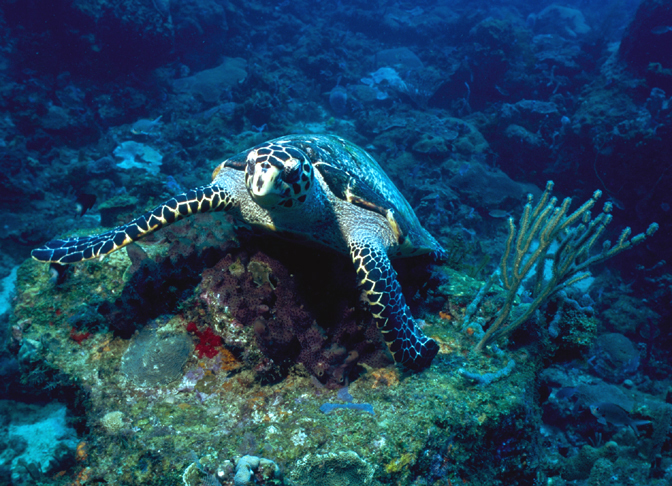Dianne Thacher
Rob Williams
Introduction to Environmental Issues
December 3rd, 2011
There May Not Be Monkeys, But It’s A Jungle Down There
Instead of jaguars sauntering through dense fauna, tiger sharks prowl by. Dugongs spend their days munching on grass, instead of gorging sloths hanging from the canopy above. Hermit crabs and crayfish crawl the ground below, instead of massive insects. To your senses, it may appear nothing like a typical jungle, but coral reefs are just as diverse, disappearing faster, and provide just as many human benefits in their natural state as tropical rain forests. In order to preserve and continue to reap the benefits from our extremely diversity, vulnerable reefs we must preserve them via; strict regulation concerning human activities such as pollution, fishing and tourism, community stewardship, personal commitment to reducing carbon emissions, and education outreach. While reefs may be out of sight and out of mind for those of us who do not reside in the warm, sandy parts of the world, we should still be ready to take up arms for some of the most important ecosystems in the world.
Human activities such as tourism, farming, littering, logging, mining, and fishing have all reeked havoc on coral reefs. Many of these practices lead to a build up of sediment, which collects on coral and limits its photosynthesis (Weber). The amount of nitrogen run off leaking into the oceans has more than doubled since 1860, mainly due to industrial farming (Miller and Spoolman, 256). Nitrogen, along with other pollutants, creates poor water quality, depletes oxygen and lowers biodiversity due to huge algae blooms called eutrophication. Dredging and bottom trawling, two types of fishing, psychically destroy reefs, and severely depletes fish populations. In 1989, the U.S Navy created a similar disaster by dragging an anchor across the ocean floor where reefs resided; fearing lawsuits, restoration was attempted but only 40% of coral fragments could be reattached (Crowder and Norse, 68-70). Direct human activities put huge pressure on coral reefs, however coral reefs have one more merciless enemy, bleaching.
Bleaching is one of the countless evils that escaped out of the Pandora’s Box that is the age of oil. While most reefs can be dated at at least several thousand years old and could take up to a millennia to regrow, bleaching can kill off coral in a matter of months. Algae and coral possess a symbiotic relationship, as algae reside inside the coral polyp. Algae in return conducts photosynthesis, providing coral with its vibrant color and life source. However, ocean acidification is ruining this process. Due to the obscene quantity of carbon we emit, the ocean is forced to absorb excessive amounts, leading to a rise in temperature, an increase in acidification and an inhospitable environment for all kinds of sea animals.
Once the water surrounding coral reefs reaches a certain level of acidity, the coral can no longer support the algae as it beings to emit toxic levels of oxygen. Sick coral then ejects algae from its body, which causes its white, bleached appearance. Without a source energy, coral cannot survive long without algae (Crowler and Norse, 69). Unsurprisingly, acidification throws off the balance of reef ecosystems in other ways as well. A rise in ocean temperature weakens the shells of crustaceans, severely decreasing their numbers. With the decrease of one population, another species, such as jelly fish in the case of reefs, seizes the opportunity to overpopulate demonstrating Darwin’s principle of the struggle for existence. Through his observation of the natural world, Darwin theorized that each species is hardwired to produce as many young as possible. With out the checks and balances that naturally occur, one species will take over and destroy its self and its environment (Darwin, 111). It is clear that vulnerable reefs will not be able to survive this massive amount of threats without human intervention, however, is it worth the time, labor, and funds to do so?
One major way to make human beings sit up and pay attention in money, and surprisingly to some, coral reefs provide a huge amount of economic value. Yearly the infamous Great Barrier reef in Australia rakes in over six million dollars a in profits and is visited by two million tourists(Goodell). While not all reefs provide such extreme profits, when practiced sustainably they support local communities through fishing and tourism indefinitely. A variety of products are also extracted from coral reefs, ranging from cement and limestone, to sunscreen. Researchers study reef organisms in search of cures for diseases such as cancer and AIDS and medical procedures such as bone graphs (Weber). While is it tough to encompass the total economic value of a reef, NOAA conducted a study concluding that United States people value Hawaii’s coral reefs at over thirty-three billion dollars a year (Sherman). This statistics includes not only direct profit, but experiences coral reefs provide and natural benefits.
Like much of the natural world, coral reefs are ancient, intricate ecosystems that have probably existed much longer than the human race. The Great Barrier Reef alone is estimated to be 9,000 years old. Yet if we continue on our current path of oil obsession, temperatures could rise nine degrees centigrade effectively demising the immense structure into slime (Jeff). While many people believe that we possess total dominion over the earth, others follow the philosophy that the natural world has just as much of a right to thrive as we do. However, these people often are outnumbered and lack the power to take effective action. But if action is not taken, future generations will never get to marvel at the natural wonders we have, among other effects we can not even begin to imagine.
The tragedy of Katrina in New Orleans should have been a wake up call for a variety of reasons, one of those being the important role of coastal habitats. Areas such as mangrove forests and coral reefs provide natural barriers against storms and flooding. During storms and times of extreme wave activity, reefs serve as a buffer between the ocean and the land. Healthy reefs are able to repair damage caused by breaking waves, but many are now simply disintegrating due to ocean acidification under the force of powerful waves (Microdocs). We will continue to see cases of extreme flooding and tragedy as coral reefs disappear, and waves break closer to shore. Unless of course, we use human action to return coral reefs to the path of resilience.
One immediate solution for weak and damaged reefs is restoration. Restoration can be done through a variety of methods such attempting to reattach toppled coral, or creating an entirely new reef from damaged coral or coral larva. At the submerged Red Sea Star Restaurant in Eliat, Israel Reuven Yosef created a “coral hospital”, where biologists nursed sick coral back to health and reattached it to an artificial reef along the windows (Miller, 264). President Clinton’s Coral Reef Task Force was successful at transplanting over thirty soft coral colonies to sandy areas, freshly scraped clean by sunken ships during the late nineties. However, reef restoration is costly, timely, and produces mixed results (Crowder). Instead of searching for quick fix solutions in the aftermath of destruction, the best solution is adequate protection through policies and regulation.
If we wish to prevent direct damage to coral from human activities, stricter regulations must be put into place. For example, in the United States it is not even illegal to kill, harm, or harvest coral (Richmond). Broad policies such as carbon tax to decrease ocean acidification, and marine protection areas are some what effective, but usually do not pack the punch or dedication as locally enforced regulations. In order to avoid the tragedy of the commons, communities in Polynesia have taken ownership of coral reefs by creating alternating fishing and non-fishing zones, preserving shoreside grasses to prevent sedimentation, and enforcing strict tourism practices. While these small communities do not possess many resources, they are dedicated to preserving the reefs and therefor their own livelihood (Richmond). The value United States residents placed on Hawaii’s coral reefs alone demonstrated that with our abundance or resources, and a strong grassroots movement based on a dedication to resource protection and personal lifestyle change, great strides could be made with the health of our reefs.
Since our government is supposedly “by the people, for the people”, our laws towards reefs should reflect that overall attitude of the people. Protection should be aimed at the largest, most diverse areas, and regulations should be updated as new research is completed. Areas of non-protection should be alternated with areas of protection, and if possible surroundings waters should also be regulated (McCook). In order to enact such strict policy, action from the people is necessary through local representatives, education outreach and commitment from local communities to step up and take responsibility for the reefs their livelihood depends on. Furthermore, we must begin to lessen our dependence on oil in order to reduce carbon emissions. While pollution, sedimentation, over fishing and destructive tourism can usually be solved through local action, ocean acidification is a global issues each and every one of us impacts. These types of prevention may require strong commitment, dedication, and personal sacrifice, but they are more effective and cost and time efficient than restoring in the aftermath of disaster.
Coral reefs are one of the most breath taking, essential, and beneficial ecosystems on the planet. While they are disappearing at least twice as fast as tropical rainforests, they possess just as much biodiversity. Ninety percent of all ocean fish spawn on coastal habitats such as coral reefs, which also act as natural storm barriers (Miller, 252). If senseless human activities such as careless tourism, over fishing, bottom trawling, and pollution are not stopped, we could very soon loose access to the natural medicinal, economical, aesthetic and experiential benefits of reefs. However, people are willing to take action to support reefs.
A survey conducted at the Mombassa Marine National Park, in Kenya discovered that tourists were willing to pay eight extra dollars per entrance fee, and locals were willing to pay two extra dollars in order to preserve the health of the reef (Ransom). If research like this was done in our country, we may discover that our higher standard of living has lead to a sense of generosity concerning our natural resources. However, funds are not enough. We urgently need strict regulation at all levels of government, community stewardship, and a personal commitment to reducing our carbon footprints if these beautiful, bizarre, breathe taking natural structures have any hope of existence in the future.
Works Cited
Darwin, Charles. "The Origins of Species: Struggle for Existence." Darwin. New York: Norton,
2001. 111. Print.
Goodell, Jeff. "Climate Change and the End of Australia." Rollling Stone Magazine 13 Oct.
2011. Print.
McCook, L. J., G. R. Almany, M. L. Berumen, J. C. Day, A. L. Green, G. P. Jones, J. M. Leis, S.
Planes, G. R. Russ, P. F. Sale, and S. R. Thorrold. "Management under Uncertainty:
Guide-lines for Incorporating Connectivity into the Protection of Coral Reefs." Coral
Reefs 28.2 (2009): 353-66. Print.
"Microdocs: How Reefs Protect the Land." Stanford University. 12 Sept. 2011. Web. 04 Dec.
2011.
.
Miller, G. Tyler, and Scott Spoolman. "Sustaining Aquatic Biodiveristy." Living in the
Environment. [Pacific Grove, Calif.]: Brooks/Cole Cengage Learning, 2012. Web.
Crowder, Larry B., and Elliott A. Norse. Marine Conservation Biology: the Science of
Maintaining the Sea's Biodiversity. Washington: Island, 2005. Print.
Richmond, Robert H., Teina Rongo, Yimnang Golbuu, Steven Victor, Noah Idechong, Gerry
Davis, Willy Kostka, Leinson Neth, Michael Hamnett, and Eric Wolanski. "Watersheds
and Coral Reefs: Conservation Science, Policy, and Implementation." BioScience 57.7
(2007): 598-607. Print.
Sherman, Ben. "US Residents Say Hawaii's Coral Reef Ecosystems worth $33.57 Billion per
Year." Online Posting. EurekAlert! - Science News. AAAS, 21 Oct. 2011. Web. 06 Nov.
2011.
Weber, Peter. "Saving The Coral Reefs." The Futurist 27.4 (1993): 28-33. Print.


